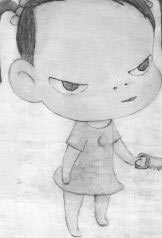SUPERFLAT
Henry Art Gallery, University of Washington, 543-2280, $6 11 a.m.-5 p.m. Tues., Wed., Fri.-Sun; 11 a.m.-8 p.m. Thurs. ends March 2002
WESTERN observers have been looking at Japanese art and getting it wrong for over three centuries, and “Superflat” isn’t going to change that one bit. Western artists have borrowed forms and techniques galore from Japanese work without capturing the melancholy essence that makes it great in the first place.
Contrariwise, the Japanese have borrowed so extensively from Western commercial pop phenomena that their youth culture looks like a tidied-up, watered-down version of your own. Then something like Takashi Murakami’s explosive traveling exhibition comes along, and you realize that once the Japanese sensibility’s done with whatever shopworn material it goes to work on, the result is ineluctably Japanese. That otherness is the most precious thing in it: It allows us glimpses of sensuous and psychic spaces we can’t get into on our own.
In the “Superflat” catalog, Murakami does what curators are supposed to do these days: provide an ideological azimuth for the work on view. He tells us to read end-of-20th-century Japanese art as a further exaggeration of the radically 2-D look of traditional media like screen and scroll painting and wood-block printing: exactly the qualities the West found most intriguing in Japanese art from the beginning.
This approach may comfort art historians, but it provides absolutely no assistance in coping with the feelings this work engenders. The strongest emotion evoked by this dreamlike assemblage of images is terror: terror barely disguised behind the Japanese equivalent of a smiley-face mask—the huge-eyed, tiny-nosed, vapidly grinning conventional child face of Japanese comic art and animated film.
EVERY Japanese artist under 40 has been saturated in this imagery since birth. Apart from a very few who have chosen to reject their native traditions entirely and to try to climb aboard the Occidental high-art locomotive, every Japanese artist has had to deal with such imagery, if only to work through and past it.
Some artists in this show, like the emigr頰ainter/performance artist who calls himself Mr., employ this beyond banal cartoon imagery straight, juxtaposing it with other Japanese visual art clich鳠like Mount Fuji. Others (the groovision group) simplify it even further, until it verges on paper-doll or Where’s-Waldo? patterns.
In the animations of Hitoshi Tomizawa, The Face explodes into fractal clouds of video-screen fragments; in Yoshitomo Nara’s paintings, it’s ironed flat into slightly monstrous infantility. Henmaru Machino turns it jolly pornographic, Chiho Aosima sickly idyllic.
Murakami’s own work spans extremes from action-figure sculptures adorned by ejaculation-track abstractions to forest skylines of pastel polychrome magic mushrooms in which only the eyes-watchful, drooping, Dal��istorted- remain of The Face.
Not all of “Superflat” is devoted to cartoon imagery. The photographs of Hiromix, for example, present old and new juxtapositions—women in traditional garb in a snowy garden setting with satellite dishes looming above—painfully familiar from second-rate Western art photography. But it’s those cartoon children, above all the barely pubescent girl child in her demure school uniform, that haunts these artists’ collective dreams.
I WONDER if any of the deeper resonances of this work can come across to gallery visitors without some exposure to the source materials driving it. The deepest and thickest underlying layer, the thick, black-and-white serial comic books known as manga, are all but unobtainable in the West and rarely translated, anyway.
But anime, the animated films for infants, adults, and above all adolescents that are omnipresent on Japanese TV, are available. I hesitate to suggest a homework assignment in preparation for an art show, but without some direct experience of anime in motion, the viewer of “Superflat” is almost sure to miss the implied kinetic energy of virtually every piece on view. In his catalog essay, Murakami pays explicit homage to Hideaki Anno’s immense video serial Neon Genesis Evangelion, and there could probably be no better introduction to or explication of “Superflat” than viewing a few episodes of NGE (which are available for rent at Scarecrow Video, 5030 Roosevelt Way in the University District): not the first episodes, which are typical repressed adolescent aggression fantasies, but those toward the end of the series, in which Anno’s neurotic teen protagonists begin to go psychotic along with the sci-fi universe they inhabit.
This is, by the most generous estimate possible, seriously disturbed stuff. But it exhibits more nakedly than any Western popular art I know the distortion of the mass psyche under the stress of modern urban life. When I see in “Superflat” a culture close to the breaking point, I’m probably just projecting, not perceiving. But that doesn’t reflect too cheerfully on my own mental tone, does it? It’ll be interesting to see what the show does to you.









